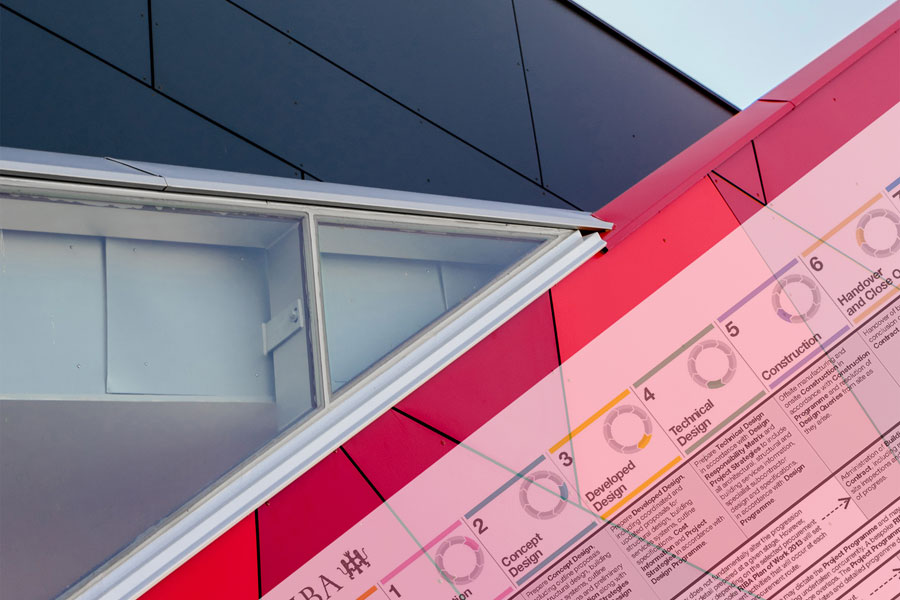
Process
We aim to design the best buildings, places, and spaces. A central part of this is providing the complete design of buildings across a range of sectors. We develop conceptual designs through to the final details, before going on site to oversee construction. We protect the continuity of the design concept and build quality.
RIBA Stage 0: Strategic Brief
Stage 0 Outcome: Identify Client Brief and/or Business Case and other core project requirements
We offer an initial meeting which can be at our offices or your site/property. We will listen to your requirements, ideas, aspirations and obtain a project brief. We will explain the processes, people, timescale and likely costs involved in your project. We will then provide a written agreement and a personalized schedule of services based on our meeting.
RIBA Stage 1: Feasibility Study
Stage 1 Outcome: Feasibility Study, Options, Site Appraisal, (Survey).
We will help you assess your options and if necessary carry out a feasibility study. We will also identify if other professionals need to be consulted. To enable us to start developing designs for your project we may need to undertake a measured survey of the site and/or property. The scope of this survey is very much dependant on the project type and scale. We will advise what is appropriate for your project.
RIBA Stage 2: Concept Design
Stage 2 Outcome: Concept drawings, Pre-Application Advice.
We will develop concept drawings based on your brief, identify any constraints and can provide precedent images to show what we envisage. The concepts will be for discussion to ensure we are meeting your brief and expectations. Your feedback is crucial at this stage, so we know how to develop the ideas into a full design solution. Together we will agree on a project strategy and timeline, and then we will liaise with the Planning Department on your behalf.
RIBA Stage 3: Developed Design
Stage 3 Outcome: Planning Application
Subject to your approval of the concept designs, we will then develop a set of plans and elevations ready to submit a formal planning application.
If needed, we will start discussions with the authorities prior to the formal submission.
This is where we spend time developing the concept design into something that can actually be built. These more detailed drawings will go beyond the shape and style of the building to include all practical considerations and the work of any other consultants. Once the developed design is agreed then we will submit it to Planning.
RIBA Stage 4: Technical Design
Stage 4 Outcome: Planning Conditions, Building Control submission Construction information, Tender documents
Once planning permission has been obtained, Technical Design is required to ensure Building Control compliance.
At this stage, it is likely that the design team will need to expand to include a structural engineer and other consultants. Once we have coordinated their designs an application can be made for Building Control approval.
The output of this work stage is a fully coordinated and detailed architectural drawing package and all of the supporting information required for construction.
RIBA Stage 5: Construction On-Site
Stage 5 Outcome: Contract Administration
We don’t just do drawings – we are trained to oversee the build and administer the building contract. For this work stage we visit site regularly, host and minute meetings, answer client and contractor queries, monitor progress, certify payments and produce ‘as constructed’ information.
Good contract administration will keep the client informed of costs and budget and if everything goes to plan the project will finish when planned.

RIBA Stage 0: Strategic Brief
-
We offer an initial meeting which can be at our offices or your site/property. We will listen to your requirements, ideas, aspirations and obtain a project brief. We will explain the processes, people, timescale and likely costs involved in your project. We will then provide a written agreement and personalised schedule of services based on our meeting.
Stage 0 Outcome: Identify Client Brief and/or Business Case and other core project requirements

RIBA Stage 1: Feasibility Study
-
We will help you assess your options and if necessary carry out a feasibility study. We will also identify if other professionals need to be consulted. To enable us to start developing designs for your project we may need to undertake a measured survey of the site and/or property. The scope of this survey is very much dependant on the project type and scale. We will advise what is appropriate for your project.
Stage 1 Outcome: Feasibility Study, Options, Site Appraisal, (Survey).

RIBA Stage 2: Concept Design
-
We will develop concept drawings based on your brief, identify any constraints and can provide precedent images to show what we envisage. The concepts will be for discussion to ensure we are meeting your brief and expectations. Your feedback is crucial at this stage, so we know how to develop the ideas into a full design solution. Together we will agree on a project strategy and timeline, and then we will liaise with the Planning Department on your behalf.
Stage 2 Outcome: Concept drawings, Pre-Application Advice.

RIBA Stage 3: Developed Design
-
Subject to your approval of the concept designs, we will then develop a set of plans and elevations ready to submit a formal planning application.
If needed, we will start discussions with the authorities prior to the formal submission.
This is where we spend time developing the concept design into something that can actually be built. These more detailed drawings will go beyond the shape and style of the building to include all practical considerations and the work of any other consultants. Once the developed design is agreed then we will submit it to Planning.
Stage 3 Outcome: Planning Application

RIBA Stage 4: Technical Design
-
Once planning permission has been obtained, Technical Design is required to ensure Building Control compliance.
At this stage it is likely that the design team will need to expand to include a structural engineer and other consultants. Once we have coordinated their designs an application can be made for Building Control approval.
The output of this work stage is a fully coordinated and detailed architectural drawing package and all of the supporting information required for construction.
Stage 4 Outcome: Planning Conditions, Building Control submission Construction information, Tender documents

RIBA Stage 5: Construction On-Site
- We don’t just do drawings – we are trained to oversee the build and administer the building contract. For this work stage we visit site regularly, host and minute meetings, answer client and contractor queries, monitor progress, certify payments and produce ‘as constructed’ information.
Good contract administration will keep the client informed of costs and budget and if everything goes to plan the project will finish when planned.
Stage 5 Outcome: Contract Administration

